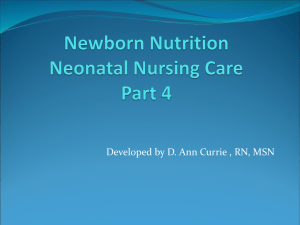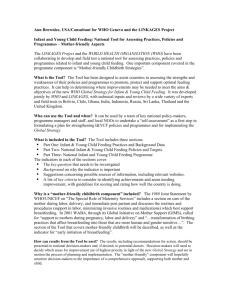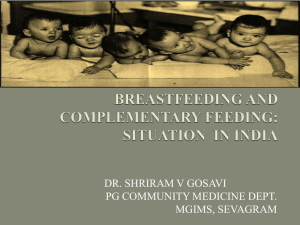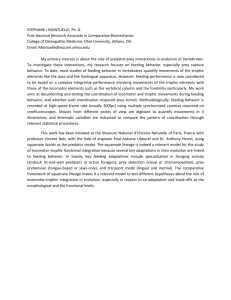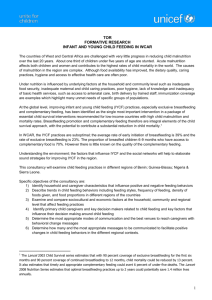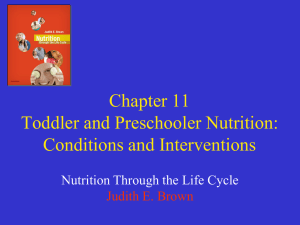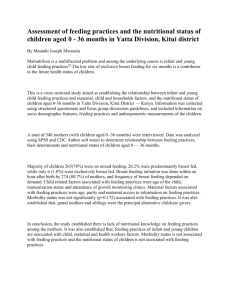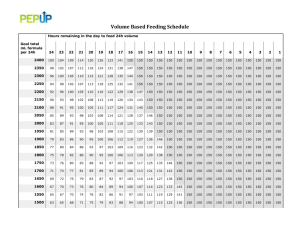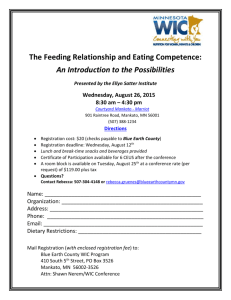Session 21
advertisement
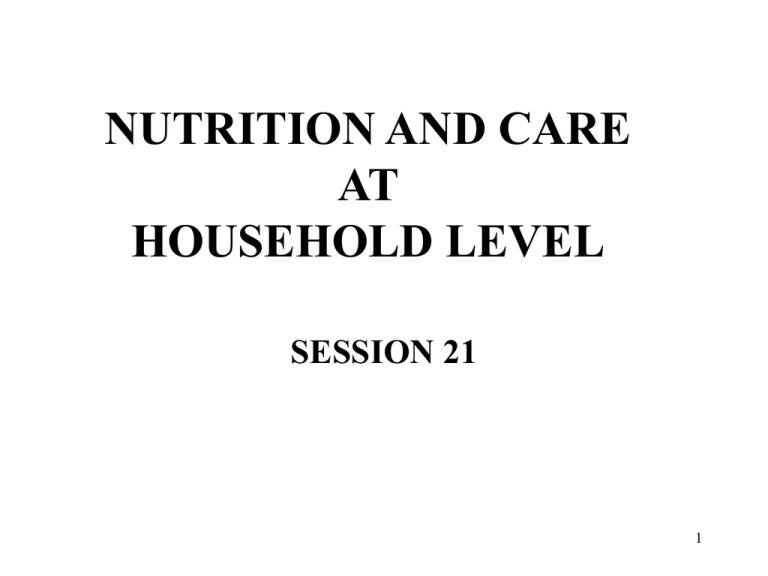
NUTRITION AND CARE AT HOUSEHOLD LEVEL SESSION 21 1 Infant Feeding Under 6 months Exclusive Breastfeeding o o o o o o o For 6 months Initiation within 1st hour after birth Breastfeeding on demand Development of skills of breastfeeding expression Protection from commercial pressures of artificial milk Breast milk substitutes Dangers of breast milk substitutes 2 Infant feeding continued • Complementary feeding and sustained breastfeeding • Timely introduction of complementary foods • Breast feed into the second year • Adequate complimentary foods (energy and nutrient dense, quantity) • Frequent feeding 3 HIV and Infant Feeding • All mothers supported to B/F unless tested +ve • Replacement feeding • Guidance and support to feed child 4 Complementary feeding • • • • • Adaptation of psychomotor abilities for feeding Feeding responsively Adequate feeding situation Adaptation to family diet Ensuring adequate intrahousehold food distribution • Appropriate response to poor appetite in young children 5 Infant Feeding continued • • • • • • • Children aged 6-24 months Cont. B/F for 2 years Complementary feeding 6 months require energy dense foods + B/M 30% of energy from oils/fats Vitamin A supplements Means & skills in food preparation, specific food commodities & utensils, fuel and water • Low birth weight babies iron supplements 6 Disabled people • • • • • • • • • • • Nutritional risks: Difficulties in chewing and swallowing Reducing food intake and choking Inappropriate position/posture when feeding Reduced mobility affecting food access and access to sunlight (affecting vitamin D status) Discrimination affecting food access Constipation particularly those with cerebral palsy Separated from immediate family members and care givers Determine and reduce risks by ensuring physical access to food Developing mechanisms for feeding (spoons, straws, developing systems for home visiting or outreach Access to energy dense foods 7 Community-based care • Caregivers and those they care for may have specific nutritional needs due to • Less time to prepare food • Have greater need to maintain hygiene & sanitation • Fewer assets to exchange for food due to costs of treatment/funerals, social stigma, reduced community support mechanisms • Reduced availability of caregivers due to disaster (family break ups/death) aged & children become main care givers • Caregivers should be supported & not undermined • Hygiene, health & psycosocial support & protection • Social networks 8 Psychosocial care • Emotional and • Attention, affection and involvement • Frequent positive interactions (touching, holding, talking • Maintenance of valuable traditional practices • Physical stimulation • Responsiveness to deve. Milestones & cues • Adapting behaviour to low activity levels and slow development of a child • Encouragement of autonomy exploration & learning • Encour of playing, exploration, talking • Adoption of a teaching or guiding role • Prevention & protection from child abuse and violence 9 Pregnant and Lactating Mothers • Risks associated pregnancy complications, maternal mortality, low birth weight, impaired breastfeeding performance • Planning rations to take additional needs of pregnancy & lactation • Supplementary feeding • Low body weight mothers focus on adolescent nutrition • Daily supplements or iron and folic acid • Diversified diet • Post-partum mothers-vitamin A within 6 weeks after delivery 10 Nutrition Care of the Elderly • • • • • • • • • • Very affected by disasters Nutritional risks Access to food Increase nutrient requirements due disease & disability, psychosocial stress, cold and poverty Normal networks support disrupted Nutritional and care needs Specifically held access food, relief food Foods be easy to prepare and consume Additional protein & micronutrient requirements of older people Important caregivers to household members, require specific support in fulfilling this function 11 Nutrition Care for PLWHA • Face greater risks due; • • • • • • • • • • • • Reduced food intake due to Loss of appetite Difficulties in eating Poor absorption of nutrients due to diarrhoea Parasites or damage to intestinal cells Changes in metabolism Incr. Energy requirements according to of infection Micronutrients imp. To preserve immune function & promote survival Well nourished & healthy to delay onset of AIDs Milled food Fortified food Blended foods 12 Nutritional Counselling • Help people make good nutrition decisions for a life time 13

